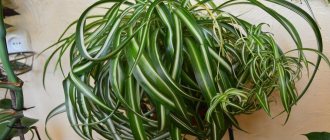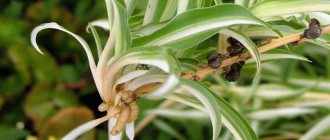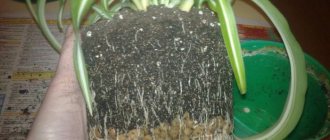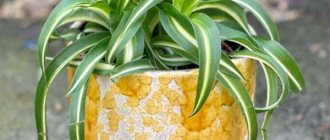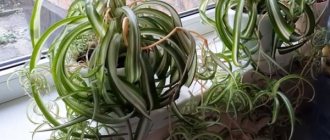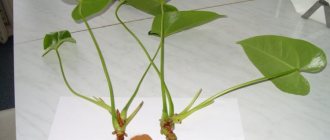Chlorophytum orange or orange, or winged chlorophytum, or fiery flash, and even fiery glory and tangerine - all these are names of one plant. And its full name is Chlorophytum amaniense, this is what botanists call it, and it is under this name that it joined our indoor flowers at the end of 2005.
For propagation as an indoor flower, we sell two varieties of orange chlorophytum:
- Chlorophytum amaniense "Fire flash"
- Chlorophytum amaniense "Green Orange"
Differences between “Fire flash” and “Green Orange” varieties
They are practically the same. Except that the coral vein in the middle of the leaf is less pronounced on Fire Flash. It’s not that it’s faded, it’s the same orange at the base of the leaf, and higher up, the orange color of the vein brightens and turns green.
Chlorophytum, with truly orange, bright, eye-catching petioles of dense green leaves, is another love at first sight for indoor plant lovers. Bright orange-coral petioles against the background of contrasting green leaves make it unusually attractive and interesting.
Fire flash is translated from English as a fiery flash - and it is truly a luminous beauty!
Top dressing
Chlorophytum orange responds very gratefully to fertilizing. To achieve a lush crown and excellent growth, fertilize your pet during the growing season 2 times a month. For this purpose, use liquid organic and mineral fertilizers intended for decorative deciduous crops. It is advisable to alternate different types of fertilizers with each other.
In addition, it is useful to water the flower with water in which activated carbon, chalk or starch are diluted.
Botanical features of "Fire flash" and "Green Orange"
Botanical name:
Chlorophytum amaniense (synonyms Chlorophytum orchidantheroides, C. Orchidastrum, C. filipendulum amaniense, Chlorophytum Orange Marmalade and others)
The plant is known by the names:
fire flash, chlorophytum orange, chlorophytum orange, winged chlorophytum, Sierra Leone lily, orchidaceous, orange spider plant and about ten more names.
Such a huge number of names does not spoil the plant itself and cannot prevent us from admiring it. We are free to call him as we want, or as we are used to, as well as by the name under which he was first introduced to us.
Plant type:
A perennial deciduous plant native to the tropical forests of East Africa in the Usambara Mountains of Tanzania.
Chlorophytum has more than 200 species. Chlorophytum amaniense is one of the species, and Chlorophytum amaniense "Fire flash" and "Green Orange" are recognized varieties of this species. It is this fact that misleads many gardeners and causes controversy and confusion.
Growing
Providing proper care for Chlorophytum orange (winged) at home is not so difficult. After all, the plant only needs the following:
- regular and abundant watering;
- frequent spraying of foliage;
- maintaining optimal room temperature;
- periodic feeding;
- transfer.
Below you will learn more about these agricultural activities.
Why is chlorophytum orange so similar to palisota?
I know of cases where flowers bought in a store died. Dissatisfied customers returned to the store with complaints. Where to look for the cause of death?
It was precisely because of the dissimilarity of “Fire flash” and “Green Orange” from the other representatives of this species that settled on our windowsills that flower growers began to have doubts. Is this flower named correctly? Are they taking care of it properly?
But the care complied with the rules for growing chlorophytums. Then maybe the object of care is not the one for which it is taken? Suspicions fell on Palisota. Look how similar they are. (Photo below) This is Palisota westlandia Commelinaceae, and it is a completely different flower from the same family as our common Tradescantia. This is the Commelinaceae family, and our hero is from the Liliaceae family. Well, of course, their care should be different.
Intrigue arose. But aren’t the stores making mistakes, and aren’t the suppliers making mistakes?
The Internet happily picked up the topic. Of course! Inflating a fly to the size of an elephant is as easy as shelling pears. But, as Vladimir Etush’s character said in “Prisoner of the Caucasus”: “Eh, there’s no need for haste, no need for haste.” Orange chlorophytum is also similar to aspidistra and many other representatives of the tropics.
In Australia there is a huge garden center Bamboo Land, which has its own online store. Great guys grow and sell plants all over the world. So they sell this plant, which causes so much controversy, under a very clever name: Chlorophytum X “Fire Flash”.
Because, they say, in fact, this is a hybridized plant and it would be more correct to spell its name with the letter X. And the actual species that were crossed to produce this beauty are unknown. So orange marmalade, aka fire flash, could look like anything, and only the breeders of the past know where they got such beauty from.
The same is true in the botanical definition of this beauty - it is a variety. That is, a plant obtained as a result of selection.
So, as Sharikov from “Heart of a Dog” said: “It definitely couldn’t have happened without a diver.”
History of the Latin name of the plant
Chlorophytum adapts perfectly to almost any environment. It has several features that allowed it to quickly spread throughout tropical America:
- unpretentiousness;
- fast growth;
- the ability to be in the ground and in the water.
Reference. Scientists still do not agree on which family this culture belongs to. Some classify it as a lily for its ability to grow in water, but others find many similarities with aspholedaceae. The name itself can be translated as “green plant”. However, chlorophytum also has several unofficial definitions - spider and green lily.
This family numbers more than 200 species. Each of them has its own characteristics. However, due to their common characteristics, they are classified as one family.
Chlorophytum orange
The evergreen perennial grows to a height of 45-60 cm. If grown in containers it will not be so tall - 25-30 cm.
The leaves are green, glossy, oval-lanceolate, pointed, with wavy edges. Leaves up to 25-30 cm long and 5-10 cm wide grow in the shape of a rosette.
Fire Flash justifies its name by creating the impression of a luminous center of the outlet. The orange color of the petioles against the background of greenery looks like a fairytale backlight.
It blooms with small white flowers collected in paniculate inflorescences, resembling a panicle of corn. The flower rises on a very short peduncle from the middle of the rosette and blooms for a week. Then small boxes with seeds are formed from the flowers. The seeds are black. The flowers have a pleasant but slight aroma.
Click to enlarge
Almost, like their distant relatives 'Fire flash' and 'Green Orange', have tiny, swollen nodules in their root systems to store water. But they do not have the tendency to produce aerial roots, like their “relative”.
Click to enlarge
Description of the plant with photo
Chlorophytum is a herbaceous plant. It has long lanceolate leaves, pointed at the ends. Arrows emerge from the middle of the bush, at the ends of which young plants develop.
The flowers are small, inconspicuous, white. After flowering, a green capsule fruit is formed. The roots are fleshy and are able to accumulate moisture, which helps to survive during periods of lack of moisture.
Benefits of green leaves
Chlorophytum is a useful plant for home and office. Its leaves absorb harmful substances from the atmosphere well, thereby helping to purify the indoor air. Actively evaporates water, increasing the humidity in the room. Green leaves, of which Chlorophytum has a lot, are also a source of oxygen. It is recommended to keep several copies in the rooms and kitchen.
Plant leaves are removed from the air:
- formaldehyde;
- carbon monoxide;
- acetone;
- other harmful impurities.
How fast does a flower grow?
In just a few months, a small cutting can produce a fairly lush plant. Chlorophytum grows especially well from spring to autumn. The speed of its development also depends on where the pot with the indoor flower is located.
Chlorophytum orange - care
“Fire flash” and “Green Orange” prefer to be in the shade, they are very unpretentious - they sit quietly in the shade and always look good. They love to grow in the fresh air. In places where the air temperature fluctuates throughout the year from 15 to 27 degrees Celsius, they feel great somewhere under the trees. Can withstand short-term temperature drops of up to 10 degrees Celsius.
So in the summer they will be happy to move to the balcony, terrace or courtyard.
Light
Only diffused light, shadow, partial shade. Does not tolerate direct sunlight, which can cause chlorosis or leaf burns. It is very good to use in offices or in the decoration of rooms where there is little light.
Surprisingly, the abundance of light inhibits the growth of this member of the family. For planting outdoors, it grows best in the shade of trees. If the leaves are exposed to direct sun, brown spots appear, like freckles, or large damage like this.
Click to enlarge
And if there is just too much light, then the leaves can discolor to an unhealthy yellow color - chlorosis.
Watering
The soil should be moist, but, like most plants, not waterlogged. It is better to use non-fluoridated water. Fluoride also causes spots to appear on the leaves. It will last a week or two without watering. It will be saved by nodules on the roots, but not to the same extent as other chlorophytums, whose roots have pronounced moisture collectors.
In nature, chlorophytum prefers floodplains, so it will be happy with humidity even in indoor conditions. Although, if on the ground excess moisture goes into the soil itself, then the gardener will have to control the humidity in the pot. The danger of root rot is the same as with other potted plants.
The soil
Any humus or organically enriched. Well drained. Slightly acidic. It’s useful to know that universal soil is slightly acidic, so you don’t need to invent anything with the soil.
Everything you need to know about transplantation
Each young plant must be replanted annually. Starting from the age of 5, the frequency of replanting shrubs should be reduced and the procedure should be carried out once every 3 years. It is better to plan the event for the end of February - the first ten days of March.
Exot has a well-developed system that quickly fills the entire space of the flowerpot. Therefore, when replanting, it is necessary to select a container a few centimeters larger in diameter than the previous pot. An excessively deep and spacious container should not be used. This is explained by the fact that until the plant completely fills the empty space with rhizomes, the above-ground part will not develop.
Before replanting, you should prepare the soil. The soil substrate consists of a certain set of components necessary for the comfortable living of an exotic pet. The following ingredients stand out:
- Leaf soil.
- Humus from fallen leaves.
- Crushed pine bark.
- River sand, fine fraction.
- Turf soil.
All components with the exception of turf soil should be taken in 1 part and only the last ingredient is taken in the amount of 2 parts. Everything is thoroughly mixed. Expanded clay is immediately placed at the bottom of the selected flowerpot. It can be replaced with polystyrene foam, sea pebbles or pieces of broken red brick. Then the soil mixture is poured to the middle of the flowerpot.
The transplanted shrub is freed from the old substrate as much as possible and placed on the ground in a new pot. Before placing chlorophytum orange in a flowerpot, it is necessary to inspect its rhizomes. If rotten or damaged areas are found, they are carefully removed and disinfected in a weak solution of potassium permanganate.
After the procedure, the bush is placed in the center of the flowerpot and covered with new soil on top. It is necessary to ensure that there are no hollow spaces left in the soil. If they form, moisture can stagnate in them and provoke the development of pathogenic bacteria.
The soil for planting is selected to conduct well not only air, but also moisture.
It is imperative to control the acidity of the soil; slightly acidic or neutral soil is ideal. It should be in the range of 6.8-7.2 pH. If you replant annually, you don’t need to apply fertilizer in large quantities. Fresh nutritious soil will provide all the necessary minerals and vitamins needed to maintain the bright color of Chlorophytum Green Orange.
Good to know:
The leaves are extremely sensitive to various chemicals, so when fertilizing, do not use foliar fertilizer, only at the root.
To preserve the strength and beauty of the leaves, remove the seed shoots unless you intend to produce seeds. Keep the plant well-groomed and dust off the leaves.
Maintain moisture during hot, dry times by placing the pot in a tray of water just above the base of the pot.
The leaves are brittle, that is, in a completely healthy state they can break in the middle and droop, like a hare’s ear.
Treatment of gummy flower
Sometimes chlorophytum is attacked by various diseases. You need to know why they appear and how to deal with them. It is worth considering this issue in more detail, since this information will allow you to save the flower.
Why do the tips of the leaves turn dark?
Gardeners quite often have to face exactly this problem. This is usually associated with the following care deficiencies:
- insufficient watering in hot weather;
- large amounts of sodium may have accumulated in the soil;
- the plant is in a cold room and needs to increase the air temperature;
- chronic drought.
These are the main reasons why leaves begin to darken. In this case, it all starts with a slight darkening of the tips. But in the absence of necessary actions on the part of the gardener, the leaves completely darken and fall off. In the future, the plant itself may die completely.
What to do if the leaves start to turn black?
If the leaves begin to darken, you need to analyze and do one of the following:
- Start watering the plant more abundantly, but in winter it requires less moisture, since it is dormant and not growing.
- Place the pot in a room where it will be warmer (it is also possible to turn on the heater if we are talking about the off-season, when it is already cold outside, but the heating has not yet been turned on).
- Change the soil. If the problem is high levels of nitrates in the soil, you need to reduce the amount of fertilizer that is added to help the plant grow.
Thus, chlorophytum does not require special care, but it is necessary to provide for several important details. Without them, the culture will die quickly. The flower has good immunity to disease, and pests practically do not touch it. But if not properly cared for, it begins to fade. If there is no action on the part of the gardener, the plant dies.
4/5 — (2 votes)
Reproduction
Propagation by seeds
Excellent propagation by seeds. It reproduces on its own. He simply drops the seeds into his pot and they germinate. The seeds will hatch approximately a month after sowing. Sowing does not require any tricks.
The seeds are quite large. If you want to control the process, then bury the seeds a little in the same pot, next to the mother plant, and when seedlings appear, replant.
Like here, in the photo below. These seedlings are from the mother plant; they sprouted on their own, simply falling from their seed pods. Photo from the site: https://plantsarethestrangestpeople.blogspot.com/2008/01/brain-chlorophytum-x-fire-flash.html
Click to enlarge
If you purchased seeds for the first time, scatter them on well-moistened soil, and sprinkle about a centimeter thick with soil on top. That's all. Water as usual along with other plants, without allowing them to dry out.
It must be said that the orange color will not appear immediately in seedlings grown from seeds. Approximately 6 months must pass from sowing, and the leaves must reach a certain size before the main characteristic of the flower appears. It is interesting that many flower growers look forward to the appearance of orange color in seedlings, but decide that this property is not transmitted by sowing seeds and, in despair, decide to throw away the seedlings. And then a miracle happens.
Pests
If you properly care for a flower, then no pests are afraid of it, because healthy specimens do not harbor insects. If there are care errors, flower growers often encounter the following parasites:
- mealybug;
- aphid;
- spider mite;
- thrips;
- nematodes.
To kill insects, wash the foliage with soapy water. It will not be possible to remove all pests in one procedure. Therefore, repeat the event at intervals of 3-4 days until you completely destroy the parasite colony. As a last resort, treat the flower with insecticides such as “Aktary” or “Aktellika”.
Soil and pot for the plant
The soil for chlorophytum should be fairly fertile, but permeable. It should not be heavy and contain clay. Does not like the flower and acidic soils. The best soil for it is soil with a normal or slightly alkaline reaction, which does not contain peat.
You can purchase suitable soil for chlorophytum at a flower shop. A light or medium soil mixture without peat is suitable for it. You should not take a heavy soil mixture, as water may stagnate in it. If you want to make the soil yourself, you need to take it in equal parts:
- Leaf soil;
- Humus;
- Coarse sand.
The choice of pot is of great importance for the growth and development of chlorophytum. Its size must be sufficient to accommodate the root system of the plant. And the distance from the roots to the walls of the pot should be at least 1 cm. The container for planting should not be high or low; it is best if its height is equal to the diameter. Plastic pots for chlorophytum are preferable. They keep the soil moist longer.

